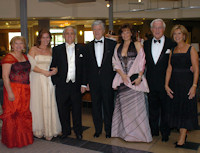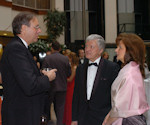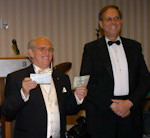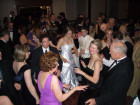|
 5/16/2009 - The Hungarian Charity Ball returned to to Washington for 2009! The 2009 Hungarian Charity Ball, organized by the American Hungarian Federation and the
Hungarian Scouts of Washington, raised funds for the Budapest based Juvenile Cancer Foundation to build an Oncology Treatment Center for Children in Hungary. Sadly, there are approximately 300 children who are diagnosed with cancer in Hungary every year. There is a great need to establish a treatment center focused on such children. 5/16/2009 - The Hungarian Charity Ball returned to to Washington for 2009! The 2009 Hungarian Charity Ball, organized by the American Hungarian Federation and the
Hungarian Scouts of Washington, raised funds for the Budapest based Juvenile Cancer Foundation to build an Oncology Treatment Center for Children in Hungary. Sadly, there are approximately 300 children who are diagnosed with cancer in Hungary every year. There is a great need to establish a treatment center focused on such children.
 On January 1, 1998, the Foundation became a "priority nonprofit organization," the first such entity in Hungary. One of the Foundation's key objectives is to build a reference 300-bed hospital and treatment center for children with cancer which would offer medical services ranging from diagnosis to sustainable treatment on the level of developed nations by highly qualified medical doctors, nurses and social workers to ensure the recovery of children. Until the full project is realized, the Foundation does its utmost to help those in need, poviding regular financial assistance to the families of children with cancer, medication, vitamins and food supplements. By 1999, it became the most widely supported non-profit foundation in Hungary. The Foundation is independent from political parties; individual politicians support its activities irrespective of their party affiliations. On January 1, 1998, the Foundation became a "priority nonprofit organization," the first such entity in Hungary. One of the Foundation's key objectives is to build a reference 300-bed hospital and treatment center for children with cancer which would offer medical services ranging from diagnosis to sustainable treatment on the level of developed nations by highly qualified medical doctors, nurses and social workers to ensure the recovery of children. Until the full project is realized, the Foundation does its utmost to help those in need, poviding regular financial assistance to the families of children with cancer, medication, vitamins and food supplements. By 1999, it became the most widely supported non-profit foundation in Hungary. The Foundation is independent from political parties; individual politicians support its activities irrespective of their party affiliations.
Read more about the Children's Cancer Foundation (Gyermekrák Alapítvány) in [ English] or [ English] or [ Hungarian]. Hungarian].
 Ambassador Ferenc Somogyi, Member of the Ball's Honorary Committee, attended the Ball with his wife, Mrs. Andrea Bors Somogyi. At the end of the ball, Frank Koszorus, Jr., Co-President of the American Hungarian Federation, presented Dr. István Balogh, President of the Juvenile Cancer Foundation, with a check of contributions from the ball's proceeds. Thanks to the Hungarian Embassy for the photos. Ambassador Ferenc Somogyi, Member of the Ball's Honorary Committee, attended the Ball with his wife, Mrs. Andrea Bors Somogyi. At the end of the ball, Frank Koszorus, Jr., Co-President of the American Hungarian Federation, presented Dr. István Balogh, President of the Juvenile Cancer Foundation, with a check of contributions from the ball's proceeds. Thanks to the Hungarian Embassy for the photos.
 Other Hungarian Charity Balls Other Hungarian Charity Balls
[back to ALL AHF news stories]
| 2009
BÁLBIZOTTSÁG / BALL COMMITTEE
- Erika Fedor (Ball Chairperson)
- Irén Högye
- Frank Koszorús Jr.
- Marianne Koszorús
- Judit Kölus
- Erszébet Tóth
Tiszteletbeli Védnökök / Honorary
Committee
- The Hon. Nancy G. Brinker, Former U.S. Ambassador to Hungary
- The Hon. Anikó Gaál Schott
- Maj. General Robert Ivany (US Army, Ret.), President, St. Thomas University
- Dr. János Horváth M.P.
- Rev. Judit Mayer, Hungarian Reformed Church
- Mr. Steven J. Varga
Chairman, William Penn Association
- Mr. & Mrs. Miklós and Sophia Zsuzsanna Wass de Czege,
on behalf of the Wass de Czege Foundation
About the
Hungarian Scouts [more]
 The
Magyar Cserkészszövetség, the primary national Scouting
organization of Hungary, was founded in 1912, and became a member of the
World Organization of the Scout Movement in 1990. The coeducational Magyar
Cserkészszövetség has 7,198 members as of 2004. The
Magyar Cserkészszövetség, the primary national Scouting
organization of Hungary, was founded in 1912, and became a member of the
World Organization of the Scout Movement in 1990. The coeducational Magyar
Cserkészszövetség has 7,198 members as of 2004.
Scouting
in Hungary is maintained through Magyar Cserkészet Tanácsa,
the Council of Hungarian Scouting. There are two associations in this
national federation, Magyar Cserkészszövetség, the
Hungarian Scout Association, and Magyar Cserkészcsapatok Szövetsége.
Also serving Hungarian Scouts is Magyar Cserkészlány Szövetség,
the Association of Hungarian Girl Guides.
Hungarian Scouting was founded in 1909 under Austria-Hungary, and the
first Scout group in the dual monarchy, MCA-1912 HAS, was founded in Budapest
in 1910. Scouting started in the separate nation of Hungary in 1919, at
the end of World War I, when Austria and Hungary were divided. In 1920,
the magazine Magyar Cserkész ("Hungarian Scout") was
first published.
Hungary was a founding member of the World Scout Bureau in 1922 and later
was a founding member of the World Association of Girl Guides and Girl
Scouts, WAGGGS, which was in fact established in Parád, Hungary,
in 1928.
In 1924, at the World Scout Jamboree in Copenhagen, Hungarian Scouts
attending their first jamboree came third in the competition of the nations,
behind British and American Scouts. They were especially good at water
sports.
The first Hungarian National Jamboree in 1926 had 10,000 participants.
Hungary hosted the fourth World Jamboree in 1933 at the royal forest of
Gödöllo, outside Budapest, in which 26,000 Scouts from 54 nations
camped together. The camp chief was Teleki Pál, the member of the
International Committee who later became Prime Minister of Hungary. This
was the first time there was a Jamboree subcamp for Scouts taking part
in aviation. To celebrate the 60th anniversary of the fourth World Jamboree,
the Hungarian Scout Association hosted a fourth World Jamboree Memorial
Camp at Bélapátfalva, Hungary in 1993.
After World War II, the Külföldi Magyar Cserkészszövetség
started operating in the displaced persons camps in Germany and Austria
in 1948 as the Teleki Pál Scout Association, renamed in 1948 as
the Hungarian Scout Association. Scouting was well organized and popular
in Hungary until it was officially abolished by the Communist regime in
1948, but remained nascent underground...
[read
more on Wikipedia]
100 ÉVES A NEMZETKÖZI CSERKÉSZMOZGALOM
- MIT JELENT EZ SZÁMUNKRA? –
Száz évvel ezelott egy afrikai szolgálatból
hazatéro angol katonatiszt elindította azt a nevelo mozgalmat,
amely mára a világ legnagyobb ifjúsági szerveztévé
fejlodött. Lord Baden Powell az ifjúság kalandvágyára
és romantikus hajlamára alapozta jellemnevelo rendszerét,
amellyel talpraesett, testben és
lélekben egészséges, jellemes fiatalokat nevel.
Az új mozgalom futótuzként terjedt szét a
világon. Magyarország az elsok között volt, ahol
nevelok és vezeto államférfiak – élvonalban
olyan kimagasló
személyekkel, mint gr.Teleki Pál és Sík Sándor
– felismerték a cserkészet értékét.
Felismerték, hogy egy cserkészszellemu fiatalság
megalapozhat egy
életképes, szilárd erkölcsi alapokon nyugvó,
sikeres társadalmat. Ezáltal a meglátás által
vezérelve, kidolgozták a magyar cserkészet rendszerét,
kiegészítve a Baden Powell-i alapokat egy jellegzetesen
magyar színezettel. Sík Sándor
fogalmazta meg legtömörebben, hogy a magyar cserkészet
célja “emberebb emberek, magyarabb magyarok” nevelése.
Hála a magyar vezetoség kiváló muködésének,
a két világháború között a
magyar cserkészet – a trianoni csonkítás ellenére
– világviszonylatban kimagasló és elismert
szervezetté vált. Teleki Pált beválasztották
a világcserkészet
legfelsobb vezetoségébe, a cserkész világtalálkozókon,
versenyeken a magyar kontingens az elsok között végzett,
és mindennek koronájaként Magyarországnak
jutott az 1933-as nagysikeru gödöllöi jemboree megrendezése.
Szinte látnoki ihlet által vezérelve, az akkori magyar
vezetoség olyan foglalkozási és nevelési anyagot,
u.n. “próbarendszert,” dolgozott ki, amely
erkölcsi és gyakorlati tartalmán kívül
kihangsúlyozta a magyar hagyományokat és kulturális
értékeket. Ez, és a magyar cserkészet elsorangú
vezetoképzo
rendszere, tették lehetové, hogy amikor a kommunista rendszer
betiltotta muködését, a magyar cserkészet zökkenomentesen
folytatódhasson külföldön. Az ötvenes évek
közepére már magyar cserkészcsapatok muködtek
nemcsak Nyugat-Európában, hanem
Észak- és Dél-Amerikában, valamint Ausztráliában
is.
A Baden-Powell-i cserkészet és annak jellegzetesen magyar
változata olyan szerencsés induló alapot nyújtott,
amelynek segítségével a Külföldi Magyar
Cserkészszövetség immár 62 éve tesz eleget
jellemnevelo és magyarságorzo küldetésének.
De nyújtott olyan alapot is, amelynek segítségével
a kommunista rendszer bukását követoen azonnal megalakultak
a magyar cserkészszövetségek mind az
anyaországban, mind a környezo országok magyarlakta
területein. Ma már a Külföldi
Magyar Cserkészszövetségen kívül a Kárpát-medence
minden országában muködnek magyar cserkészszövetségek,
összesen hét szövetség, amelyek közös
rendezvényekkel, programokkal és egymást támogatva
munkálkodnak az összmagyar fiatalság
nevelésén és nemzeti öntudatának megorzésén.
És így, egy angol katonatiszt által száz éve
elindított gondolat adta meg azt a keretet, amelyen belül
a négy évtizedes kommunista uralom alatt külföldön
ápolhattuk külföldi fiataljaink magyar nyelvtudását
és nemzeti érzését, hogy aztán a szovjet
birodalom bukása után, országhatárokat áthidalva,
összekösse a
Kárpát-medencében és a világ minden
táján élo magyar ifjúságot. - Dömötör
Gábor
 Sign
up for the AHF mailing list. Your information is not shared! Sign
up for the AHF mailing list. Your information is not shared!
|



